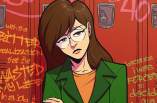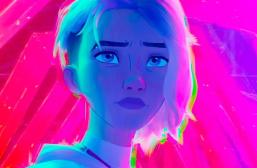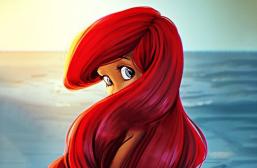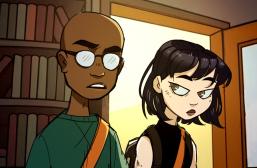The Emperor’s New Groove: Features that Enhance Kuzco’s Change

The Emperor’s groove: “The rhythm in which he lives his life! His pattern of behavior!”
Disney’s The Emperor’s New Groove centers around the character growth of selfish Kuzco, emperor of a fictitious Mesoamerican civilization, and self-proclaimed “King of the World.” When Kuzco fires his advisor for exercising too much power, she and her assistant retaliate in a conspiracy to poison him. Fortunately, the poison they meant to use against him is accidentally swapped with a potion that will have the annoying yet benign effect of turning Kuzco into a talking llama. The transformation on the personal level is not immediate, but the change in Kuzco’s form gives him the time and circumstances that facilitate his transition by stripping him of those luxuries and pleasures that feed his smallest want. Kuzco holds onto his old groove for a considerable amount of his time as a llama, but after he transforms back into a human his new groove endures. By the end of the flick, he has embraced his new groove as a happier, kinder, human being. Since The Emperor’s New Groove is not about someone who goes on a journey just to make everything return to normal, the focus on Kuzco’s internal war and ultimate change requires amplification. It achieves this heightened emphasis with a multitude of stylistic choices, including the film’s unique narrative structure, Kuzco’s evolving theme song, the suggestion of rebirth, and the contrast of Yzma and Kuzco.
Narrative Structure

By elevating its main character Kuzco to the level of narrator The Emperor’s New Groove takes the story to a whole new level. The movie opens with the onscreen words “Long ago, somewhere deep in the jungle…” but this is Kuzco’s story, and as such he is the only one with the authority to tell it. For Kuzco, hindsight is impossibly 20/20. The comedy’s well established creative license even grants Kuzco the privilege of being able to break the fourth wall and pause the progression of the movie when his ego wills it. Although favoring Kuzco’s perspective, the point of view is third person omniscient. That way, we are privy to scenes to which Kuzco was not witness and enjoy the dramatic irony of knowing Yzma’s intent for revenge even while he tells the first part of the story.
The film is split into two unequal parts on either side of the scene when Kuzco sits alone with his clouded thoughts. Everything leads up to that crucial moment in the rain, making it even clearer that the narrative centers around Kuzco’s internal struggle to change himself. While he narrates he essentially brings the audience up to speed on his life, so after this scene Kuzco will cease his commentary. The fact that Kuzco is reflecting upon the past allows the narrative structure to be given rationality. For him, the future beyond that stormy moment does not exist yet. In other words, when Kuzco breaks the fourth wall, it is not as though we are just watching the documentary of his life with him, but that we are somewhere in his brain, listening to him as he reflects. The empathy between audience member and Kuzco is so strong in fact that it is unclear whether Kuzco-the-narrator is actually defending his image and past behavior against his current self’s judgement or ours.
Kuzco himself is split into two voices: the “Winner” and “Loser” as he calls them, respectively the spoiled human living in the castle and the forlorn llama in the rain–two voices in one body vying for control. By taking on two personalities, like a Dr. Jekyll and Mr. Hyde, Kuzco becomes his own foil, each of his bad choices making his good ones carry the weight of even more meaning. Kuzco could have waited and told his story completely in past tense, looking back on how stupid and selfish he was and thanking his lucky stars that he was given the opportunity to change his life, but this way is much more effective. We get to watch Kuzco work through his problems and face reality, and this works to emphasize the difference between who he was and who he becomes. We take the journey with him. We are there with him as he reflects upon the events leading up to the lowest moment of his life when the truth empowers him with the freedom to change.

The narrative begins with Kuzco holding onto his grandeur, and strutting his ego. Naturally feeling betrayed and victimized after hearing Yzma’s plot to kill him, Kuzco defends his actions—through his imperial right to entitlement—and condemns those who have had a hand in bringing him down. So vulnerable, exposed to the audience in his lowest moment, Kuzco is inspired by his shame to look back on the good old days when he was a somebody. To save face, he distracts the audience with the illusion of happiness that he lived with for so long.
Interestingly, when Kuzco mentions the people who ruined his life, the first person he uses as an example is Pacha, not Yzma and Kronk. He says that Pacha is trouble, contradicting what we actually see of him, because he is the one who has most affected Kuzco and made him uncomfortable with his identity. The DVD commentary reveals one reason for why Pacha enters the picture here. Randy Fullmer (Producer) explains, “In the early going we had a number of different arrangements as to when we would introduce Pacha. We finally decided that because Kuzco had been introduced as such a sorta bad guy it was time to bring in John Goodman’s really friendly, well grounded nature as Pacha–get him in the movie right away to sort of balance how we had set up Kuzco.” To introduce Yzma and Kronk would be to simply add more antagonists, since it is unclear that Kuzco is anything more than an arrogant self-centered prince.

Releasing tension is vital to keeping an audience interested, but since this is Kuzco’s mind reflecting on the past–his train of thought– the order in which he chooses to tell his story is crucial. Beginning with Pacha demonstrates his mind’s obsession with repelling what Pacha symbolizes—compassion, trust, humility, and mercy. These qualities of “weakness” have worked their way into his new groove in a way that they could not have before Kuzco realized Pacha’s sincerity and strength of character. The war in Kuzco’s head reveals early on that he really does have a heart, a heart in turmoil but a heart nonetheless. Pacha, meanwhile, is well balanced psychologically. If he wants, he can let Kuzco die to save his village. It almost appears that he will do just that when he grumbles, “No Kuzco. No ‘Kuzcotopia.’ Solves my problem.” Pacha always does the right thing however, and strives to see the good in others too. Introducing Pacha first gives him added importance as an instigator of conflict, because Pacha’s good influence is what causes the most psychological struggle within Kuzco.
Even as an unreliable narrator, Kuzco cannot help but admit that “as bad as he [Pacha] is, he is nothing compared to what’s next” and goes on to introduce Yzma (and Kronk as an afterthought). When he mentions Yzma, it is not to accuse her of betraying his loyalty and attempting to kill him, but to show the last straw that led to her being fired. While not mentioning her revenge right away keeps it a surprise for the audience, it also suggests that her act of revenge is less important to Kuzco than the darker part of himself that she symbolizes. She threatened his position with her uncontrollable need for power, and after she assumes he is dead and dealt with she happily takes his place. To do so not only means that she has taken away his power, but that she has given him a taste of his own medicine. The palace is Kuzco’s home, and she has stolen it to make way for her own enjoyment–just as Kuzco had planned to do to Pacha with Kuzcotopia.

When time catches up to the present, Kuzco cannot bear the egotistical voice of denial in his head any longer. Pacha’s prophecy has come true, and he knows it: “Someday, you’re going to wind up all alone, and you’ll have no one to blame but yourself.” Finally, Kuzco comes to terms with reality, and accepts responsibility for his actions. He tells the bully in his head, the one who has tried to defend the old groove, “Hey give it a rest up there, will you? Who are you kidding, pal? They saw the whole thing. They know what happened. Just leave me alone.” The audience, like him, now knows that he has not been “the nicest guy in the world” and that he is the only one to blame for pushing Pacha away.
Theme Songs
What makes Kuzco’s theme song so interesting is that it is not just some background music for the audience’s benefit. While it does provide exposition, it is his GROOVE, it is the musical representation of his lifestyle, and a mode of self indulgence. The theme music could even be part of his daily routine–self-affirmation from someone (Theme Song Guy) whose job it is to tell him what he wants to hear. However, the theme song from the beginning of the movie leaves us with a string of rhetorical questions: “What’s his name? Is he hip or what? Don’t you know he’s the king of the world?”
Therefore, although the song helps to introduce him and gives voice to his massive ego, it also introduces subtle doubt. The song repeats over and over that the guy we see is named Kuzco. But who is Kuzco? Kuzco is already obviously wealthy and powerful, so including Theme Song Guy crosses the line between arrogance and overcompensation. Forcing his theme song on a captive audience is a way for him to hide the fact that he needs constant reassurance that he is leading a fulfilling life.

Significantly, Kuzco critiques Kronk’s silly theme song as he looks back on the scene he missed while being carried by Kronk, unconscious, from the palace. Intending to make his actions seem dramatic or inconspicuous, what Kronk really accomplishes is the opposite. Kuzco narrates the sequence with a tone that makes the audience imagine him rolling his eyes: “Ugh. He’s doing his own theme music?” But how is Kronk’s theme song any worse than Kuzco’s? His hypocrisy only serves to strengthen the evidence for his inner transformation. The current Kuzco is now embarrassed by his own theme song but since he is still too proud to admit as much Kronk becomes his scapegoat.

Even though Kuzco is ashamed of his old groove, he does not exactly lose his theme song at the end. Like him, it transforms, keeping the same tune but taking on new lyrics. Again, it is the musical manifestation of his lifestyle, and its change signifies the complete formation of the Emperor’s “new groove.” Where the previous version of this theme song ended with questions and Kuzco’s name, this one is composed completely from statements and ends with the word “us.” Kuzco has finally developed his identity by realizing that he cannot achieve happiness at the expense of someone else.
Death and Rebirth
A movie about change and second chances, it is fitting that The Emperor’s New Groove begins on the eve of Kuzco’s eighteenth birthday. If Yzma had her way he would have died that very night. Birth and death are suddenly intermingled when she plots revenge, but by some miracle the llama potion label on the vial is illegible and Kuzco survives. Pacha travels on foot back to the village, with Kuzco on his cart that night, walks all day the next day, and arrives home when it is dark again. Kuzco is unconscious for all of it, and almost completely misses his birthday, but that same night he is once again born, released by Pacha from the sack Kronk stuffed him in.

A llama with nothing to his name, Kuzco does not see his transformation as the blessing that it is. Delirious, first he suspects Pacha for being responsible for his predicament, since he had the motive. Then he stops searching for the cause of his transformation and simply resolves to focus on a solution. In this way, he protects himself from the obvious truth–truth that would only take a little reflection to reveal–that the last event before he passed out was dinner with a mad scientist. Yzma’s “practically raised him” however, and in his emotional vulnerability Kuzco is not ready to accept her betrayal.
In order to show his change of perception, it is important that Kuzco not realize the blessing of rebirth that he has been given. Being turned into a llama is not a random occurrence, a cruel prank, or an intentional punishment—it is the product of Yzma and Kronk’s mistake. Their aim was to kill. For a long time, that crucial fact remains a mystery to him, along with its fortunate corollary: the fact that Yzma’s plot is unsuccessful means that Kuzco has a second chance at life. Until he realizes this, he will still think that being a llama is simply a kink in his groove and that the only change he needs is the one that reverts everything back to the way it was.

Kuzco does not experience this revelation until he sits in the rain, shocked by the implications of the conspiracy he overheard Yzma and Kronk discussing. Before that, though, Pacha can see Kuzco’s potential to become a better, empathetic, person. When Kuzco nearly drowns, Pacha breathes life back into him, a gesture that Kuzco tries to ignore. He understands what Pacha has done for him however, and later returns the favor by saving his life too. Once again, it is the contrast between life and death that demonstrates Kuzco’s potential to change, and his inclination away from evil. Believing so firmly that Kuzco is a good person, Pacha agrees to take him back to the palace without demanding Kuzco promise not to invade his village. He simply tells him “four days is a long time. You might change your mind.” Kuzco slowly warms to him, and Pacha’s confidence in him encourages Kuzco during his internal struggle to stop feeling sorry for himself and make a fresh start in the morning after the storm has passed.
Yzma vs Kuzco

Before Kuzco completes the arc of his new groove, he and Yzma are practically interchangeable; both are vain, power hungry, and selfish. They both bully those with less power, such as peasants and squirrels. They both prefer to have others bear the burden of carrying them rather than having to exert energy themselves. When they are no longer human the part of themselves that they are most upset at losing is their “beautiful” faces, not the use of their hands. When Yzma feels frustrated, she blames Kronk, and when Kusco feels helpless he blames Pancha–treating the person that is trying the hardest to help them as though he is expendable. Even the kingdom finds it hard to discern a difference between the two of them. The subjects act apathetic toward both ruling figures: as much as they do not express sorrow for Kuzco’s death, neither do they celebrate Yzma’s coronation. As similar as they are, however, Yzma is also Kuzco’s foil because their parallels are what draw attention to their differences.

Kuzco’s big flaw is that he throws off everyone’s groove just to keep his own. He is not interested in negotiation or compromise, and why should he be? He’s the emperor, and to him that means his universe begins and ends with “me.” His every want and need comes first, and often at the expense of others’. Yzma’s take on life is not much different. When a peasant appeals to her to show mercy on his starving family she responds, “you should have thought of that before becoming a peasant.” Pacha also seeks mercy from Kuzco since his village is going to be replaced with a theme park. To his question of where they are all supposed to relocate, Kuzco answers,”hmmm, let’s see…Don’t know, don’t care.” Yzma and Kuzco start off treating people cruelly, but unlike Yzma, Kuzco is able to change.
Yzma must remain cruel, and she must be harsher than Kuzco because this makes it clear that she is the constant antagonist while he is the developing protagonist. He may be rude and petulant, but in the end he does not kill to get what he wants. He saves Pacha’s life even though he opposes Kuzcotopia. Yzma, on the other hand, has no problem ordering Kuzco’s assassination if it means being rid of her rival to the throne. In contrast to the lengths Yzma goes to, Kuzco is able to receive the audience’s approval because he holds onto his innocence. When Pacha looks dumbfounded that Kuzco showed him mercy, Kuzco answers with the echo of Pacha’s previous assertion that “nobody’s that heartless.” Yzma, might just be the one who is the exception. Kuzco appeals to her with his new-found belief in people, telling her “Okay, I admit it. Maybe I wasn’t as nice as I should have been. But–Yzma…Do you really wanna kill me?” She does not take his roundabout apology as the opportunity to start over anew. Her power is still all that matters to her, so their paths diverge. Where Kuzco is granted a second chance as a human, she is punished by remaining a cat.

Besides Yzma and Kuzco being contrasted by blood thirst, they are also differentiated by their ability to find strength through a friend. After the rain scene, for instance, Kuzco and Pacha run side by side like equals, while Yzma continues to make Kronk carry her. This change in relationship is paramount to how evil fails to triumph despite having the upper-hand. Yzma calls her dependence on Kronk a “cruel irony” and treats him as though he is another obstacle in her way. Like her, one of Kuzco’s greatest dilemmas has been to find closeness in someone else. What Kronk says of Yzma could just as easily be used to describe Kuzco: “There’s a wall there.” Kuzco repeatedly tells people “no touchy!” when they come near, but has no problem showing his self love by hugging his Kuzcotopia model.

By the end, Yzma will have completely forced Kronk away from her while Kuzco will have changed his Kuzcotopia model into a bird house and shared a few hugs. As his unlikely ally, Pacha helps Kuzco retrieve and ultimately remove the cork from the potion that turns him back into a human. Yzma, on the other hand, remains as cold at the end of the movie as she is in the beginning. Her inability to cooperate with and care about Kronk is a primary factor in sealing Yzma’s fate. Without anyone by her side who cares about her, she cannot open the potion bottle even when she has it within her very paws.
The narrative structure, theme music, the switch between Kuzco’s ignorance and understanding of his second chance, and Yzma’s contrasting attributes, all contribute to the struggle and change that occurs within Kuzco. These make it clear that Kuzco is not a victim who is trying to set things right, or a villain doomed to punishment as a llama. He is a person who has been given the opportunity to live a happier life by learning to care about someone other than himself, and several factors go into supporting his transformation. By filling the role of the narrator, Kuzco is able to reflect on his past actions, and the majority of the film is consumed by the internal struggle that he experiences one stormy, lonely, night. The adaptive quality of his theme music reflects the flexibility of his groove. In the beginning, he cannot change because he does not recognize that he escaped death, and that he was reborn on his eighteenth birthday to grow into a better person. Finally, Yzma provides the contrast that shows Kuzco can be redeemed. She fails where he succeeds because she pushes away the only person who cares about her, and only sees perfection in herself where there is greed and hatred.
Works Cited
The Emperor’s New Groove. Prod. Randy Fullmer. Dir. Mark Dindal. Perf. David Spade, John Goodman, Eartha Kitt. Walt Disney Pictures, 2000. DVD.
What do you think? Leave a comment.











This is one of my favourite disney movies, it’s so funny…
I agree. As many times as i’ve seen this movie over the years, it still cracks me up like no other Disney movie.
1).Krunk humming his own theme music while sneaking around.
2).Old man throwing off emperor’s groove.
3). Krunks proposing dinner, desert, and coffee in the middle of a crisis.
4). Yzma turning into a cat
5). Any scene involving krunk
Pretty bold move on Disney’s part to make the lead character so utterly despicable, and thereby give him such a huge arc of redemption. The only reason they got away with it is because of the non-stop humor.
I think part of the power of humor is the agency that it gives the writer to make such a bold, sweeping turnaround. Disney did an excellent job with this film!
i remember i was reluctant to watch this movie at first when it came out. i thought it looked stupid and lame, and had a weird premise i didnt think would be entertaining.
man when i first watched this movie i then starated to watch it constantly.
the part where kronk is running with the bag and freezes while hes singing the song and sneaking… oh man im laughing just thinking back to it.
It movie was just too fast! If it slowed down and had a more contemplative pace, it could have been brilliant.
I’ve watched some of the classic Disney animations, not this one.
Love the title change! Excellent article, I’ve never really thought about the film in this way. Very cool insights!
Love The Emperor’s New Groove! I enjoyed reading about how Kuzko’s transformation served as a rebirth. I never saw it that way until now.
Kronk is awesome
I loved this article also with the narrative structure this same idea carries on into the sequel Kronk’s New Groove ( suprisingly funny if you were wondering) where whilst Kuzko appears to remind the audience it is Kronk movie he and Kronk talk over it and break the fourth wall
The way you broke down this entire film is absolutely phenomenal. I will admit I was captivated by Kuzko’s astounding confidence (Theme Song Guy’s song was really catchy) and I had not realized that it was another layer of overcompensation. Amazing work!
“Pull the lever Kronk!”
I remember seeing this when I stayed home one day at age 10 and must have watched it about 5 times that day and as I got older (I’m 21 now) it has gotten better and better.
I can say that about most Disney movies. Many of the jokes in them go over childrens heads and rewatching them later on in life gives you a much better appreciation for them and new meaning each time. Some examples are The Lion King, Beauty and the Beast, etc.
I love this movie and it is GROSSLY underrated. It is the FUNNIEST Disney movie out there. So many awesome one liners and sight gags it continues to be one of my favorite movies.
Just the other day, my sister and I were walking and randomly turned to each other and said “Eh, Pacha?” which ensued in us bursting out in laughter and continuing this quote throughout the day. Now whenever I call her that is the greeting I get!
This is one of the most underrated Disney movies ever. This is such an amazing movie and Kuzco gets great character development given the short run-time of the film. One of my favorites, great article.
Kuzco is perhaps one of the most developed characters in all of Disney because there are so many dimensions to him. You touched upon this rather well in a way I should have but never did notice. Kuzco was arguing with himself the entire time, thus giving an underrated character in a funny, underrated movie great development.
The movie’s power comes from its humor and this is probably why it is looked down upon. Disney usually does tragedy and fairy tales, not comedies. Especially not comedies that make fun of the usual films (prophetic dream, mouth-to-mouth kissing, and the waterfall coming at the end of the river.
Great article!
Now that I think about it, this movie is even more awesome because it manages to redeem such an odious character. Honestly, it’s one of the best non-Princess Disney films around. I remember not liking it so much as a child, whereas now I keep re-watching, and laughing at all the same parts. Thanks for the article, nice to see a rather underrated Disney film get some love!
Who wrote this? Its wonderful. Exactly the type of resource I have been searching for my son’s 6th grade project. A name and date on the article is needed for school purposes.
Very well done. Thank-you for taking the time to share!
You can cite me–Constellation. I wrote this Jun 30, 2014. Was it really so long ago?
Thank you very much! What kind of project is it, I wonder?
He has to write a paper on either a drama or a comedy. It was supposed to be more play leaning, but the story lends itself to a play. He focused on the setting, the costumes and the use of narration. I searched high and low to find a well-written, insightful piece for him to use as a resource.
For me, I enjoyed reading the essay. It was fun to explore the movie a little further, than I had previously.
I’m glad to hear it! I think it’s funny that my critical analysis would be referenced in homework since it was made as a way for me to escape the constraints of homework. Thank you again, and I’m glad you enjoyed it 🙂 I hope it applies, even though it is not a play.
A great analysis of one of my favorite Disney movies! Nice work. This movie needs a lot more credit for its excellent character development.
Brilliant analysis, thanks!
P.s. I’m learning about screenwriting so this is really helpful. I’ve been trying to think what Kuzco’s strengths are, given that every protagonist has to have some, and I came up with high self-esteem, a belief in his own value and the fact he’s extremely funny; but at the beginning it’s difficult to think of many others!
This shows is one’s motives and change of motives can play a major role.